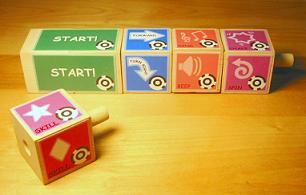Tangible Programming Languages A practical approach to computer programming in educational settings.
# Overview

Tern is a tangible computer language designed to provide a painless introduction to computer programming for children in educational settings. With Tern you can create programs for robots like the LEGO Mindstorms RCX or the iRobot Create. Tern is featured in a permanent exhibit at the Boston Museum of Science (opens new window) called Robot Park (opens new window). It is also being used for the Tangible Kindergarten (opens new window) project at the Tufts University Developmental Technologies (opens new window) group.
# Programming with Wooden Blocks

To create programs with Tern, you don't use a mouse or keyboard. Instead, Tern allows you to create physical computer programs using interlocking wooden blocks that represent actions for your robot to perform. With Tern there is no such thing as a syntax error. The shape of the interlocking blocks creates physical syntax that prevents the creation of invalid programs. Tern programs can be compiled in a matter of seconds with the press of a button.
# How It Works

Tern's wooden blocks contain no embedded electronics or power supplies. Instead Tern uses a standard webcam connected to a desktop or laptop computer to take a picture of your program, which it then converts into digital code using the TopCodes computer vision library (opens new window).
# People
Tern was created by Michael Horn (opens new window) at the Tufts University. It is currently being developed as part of an NSF-funded collaboration between the Tufts Developmental Technologies Research Group (opens new window) and the Tufts Human Computer Interaction Lab (opens new window). Tern's team members include:
- Michael Horn (opens new window), Tufts HCI Lab
- Erin Solovey (opens new window), Tufts HCI Lab
- Jordan Crouser (opens new window), Tufts HCI Lab
- Robert Jacob (opens new window), Tufts HCI Lab
- Marina Bers (opens new window), Tufts DevTech Group
- Emily Lin, Tufts DevTech Group
- Rachael Fein, Tufts DevTech Group
- Taleen Agulian, Boston Museum of Science
- Dan Noren, Boston Museum of Science
# Press
- [Apr. 28, 2009] University of Cambridge Article (opens new window)
- [Oct. 1, 2008] Tufts Journal Feature (opens new window)
- [Feb. 1, 2008] Museum of Science podcast (opens new window).
- [Jan. 31, 2008] An interview on NECN TV (opens new window).
# Video
This video shows Tern in use at the Boston Museum of Science.
# Publications
Tangible programming in early childhood: revisiting developmental assumptions through new technologies: Childhood in a digital world, Bers, Marina Umaschi, and Michael S. Horn. High-tech tots: Childhood in a digital world. Information Age Publishing, 2009.
Comparing the use of tangible and graphical programming languages for informal science education, Horn, Michael S., et al. Proceedings of the SIGCHI Conference on Human Factors in Computing Systems. 2009.
Tangible programming and informal science learning: making TUIs work for museums, Horn, Michael S., Erin Treacy Solovey, and Robert JK Jacob. Proceedings of the 7th international conference on Interaction design and children. 2008.
Tangible programming in the classroom with tern., Horn, Michael S., and Robert JK Jacob. CHI'07 extended abstracts on Human factors in computing systems. 2007.
Designing tangible programming languages for classroom use, Horn, Michael S., and Robert JK Jacob. Proceedings of the 1st international conference on Tangible and embedded interaction. 2007.
# Download & Contact Info
We will post open source software and fabrication templates here soon. In the meantime, please email michael.horn [at] tufts.edu for information.


